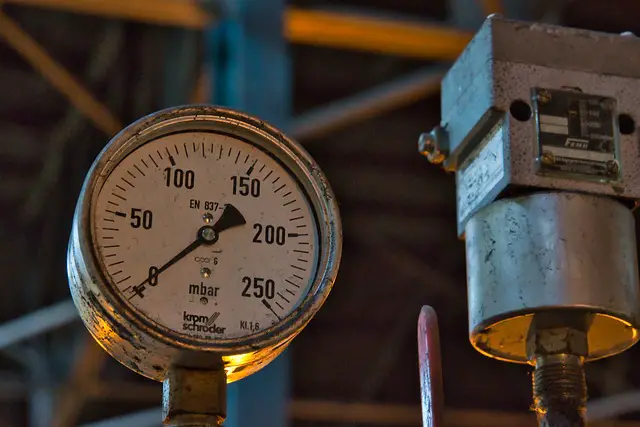Refrigerant pressures, they’re the heart and soul of your air conditioning system. They may seem like mere numbers on a gauge, but those numbers tell a story – a story of heat being whisked away to leave cool comfort behind. It’s high time you learned to speak their language, don’t you think?

Table of Contents
Measuring Refrigerant Pressures
So, how do you translate these cryptic figures into something meaningful? First off, you need the right tools.
Tools for Measuring Refrigerant Pressure
There are two trusty sidekicks in the HVAC world: the manifold gauge set and the electronic refrigerant pressure sensors.
Manifold Gauge Set
Good old manifold gauges. They’re as classic as a ’65 Mustang and just as reliable. Don’t be put off by all those tubes and dials – they’re your gateway to what’s happening in the hidden world of your cooling system.
Electronic Refrigerant Pressure Sensors
Now if you’re more of a tech aficionado, you might lean towards electronic sensors. They’re like the smartphones of the HVAC world – sleek, smart, and they give you all the info you need in a snappy digital format.
Steps to Measure Refrigerant Pressure
So, you’ve got your gear. What now? Time to get hands-on!
Preparing the System for Measurement
Before you dive in, make sure your system is ready for a check-up. It’s a bit like preparing for a doctor’s visit. You want everything in normal working order, no extra chill or heat. Once you’re set, it’s time to connect your gauge or sensor.
Reading the Gauge or Sensor Display
Now comes the moment of truth: reading the display. Take a deep breath – it’s not as complex as it looks! Focus on the PSI reading. That’s your refrigerant pressure.
Interpreting Refrigerant Pressures
Okay, you’ve got a pressure reading. But what does it all mean? Let’s decipher the code.
Normal Pressure Ranges and What They Mean
You might wonder, what’s normal? Well, it’s not a one-size-fits-all situation. Each type of refrigerant has its own typical range.
Normal Operating Pressures for Common Refrigerants
For instance, R-22, a common refrigerant, usually sits around 75 PSI on a mild 80-degree day. R-410A, the new kid on the block, runs a bit higher, around 125 PSI. These are ballpark figures, of course. Always check your manufacturer’s specs for the real deal.
Factors Influencing Normal Pressures
Several factors can affect these numbers. Think outdoor temperature, indoor heat load, or the age and health of your system. It’s like the weather – it can change based on various elements.
For more articles on refrigerants, click here: Articles on Refrigerants: The Ultimate Guide to Understanding Them
Abnormal Pressures and Troubleshooting
So, what happens if your readings are way off base?
Symptoms of Low Refrigerant Pressure
If your pressure’s too low, you’re not gonna feel the chill you’re after. It’s like trying to run a marathon with no breakfast – your system just can’t perform without enough refrigerant juice.
Symptoms of High Refrigerant Pressure
Too high, and you’ve got a different problem. Your system’s working overtime and that’s never good. It’s like revving your car’s engine in neutral – a lot of noise, a lot of heat, but not much cool air.
Common Causes and Solutions for Abnormal Pressures
Low pressure can point to a leak, while high pressure might mean a blockage or overcharge. But don’t fret! Call in a pro, and they’ll have your system humming again in no time.
Safety Precautions When Handling Refrigerant Pressures
Remember, safety always comes first. You’re dealing with high-pressure gases here, not just tweaking the settings on your TV.
Personal Safety Measures
You’ve gotta gear up before you start.
Protective Gear and Handling
Grab a pair of safety glasses, gloves, and avoid skin contact. Kinda like a chem lab, but at home. And remember, always work in a well-ventilated area.
Emergency First Aid Steps
In case of an accident, know your first aid steps. And always, always have the poison control number handy. You might never need it, but better safe than sorry, right?
Environmental Considerations
And don’t forget, we’ve got a planet to protect, too.
Proper Refrigerant Disposal
If you’ve got leftover refrigerant, don’t just chuck it in the trash. Take it to a recycling center. It’s a small step, but every bit helps.
Alternatives to High Global Warming Potential Refrigerants
Consider eco-friendly refrigerants. They’re like the electric cars of the HVAC world – just as effective, but much kinder to Mother Nature.
Conclusion
See? Understanding refrigerant pressures isn’t rocket science. It’s about learning to listen to your system, interpret its signals, and respond appropriately. Keep your system happy, and it’ll return the favor with cool, comfortable air. So, ready to become a refrigerant pressure pro?